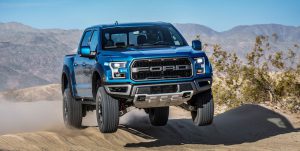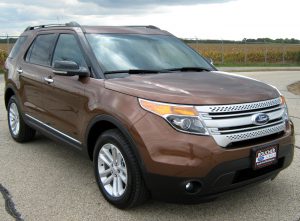
It seems counter-intuitive, but modern car engines are getting smaller and smaller, while making more and more power, and the “secret” is turbochargers. European sports cars like the Audi S4 and S5, BMW M3, Maserati Quattroporte and many others have replaced their loud naturally aspirated V8s with smaller turbocharged V6s, but you might be surprised that the humble Ford F-150 have done it first
The first factory turbocharged cars were 1960s rarities like the Chevy Corvair and Oldsmobile Jetfire, but the technology became more common in sports cars from the 1980s, usually accompanied by exciting TURBO graphics and a healthy dose of lag . Early turbocharged engines had to use a relatively low compression ratio to be ready for the pressurized intake air; otherwise the pressure inside the cylinders could build up too much and start to blow things up. This meant they were VERY slow at low RPMs and couldn’t make much power until higher RPMs when the turbo was spinning enough to create boost, but that’s not very practical if you’re just going to the grocery store and not doing that. you definitely want to stay on the throttle until 6000 RPM.
In the 1990s, the Mk4 Toyota Supra and FD Mazda RX-7 used sequential turbochargers to combat turbo lag. These vehicles had two turbochargers; a small one that wound up quickly to reduce lag, and a much larger second one to boost much more at higher RPMs and get the headline-grabbing horsepower numbers. Some diesel trucks use compound turbocharging, which is similar to sequential, except that the smaller turbo feeds directly into the larger one to get the latter to spool up even faster. But the technology that pretty much killed the turbo lag concept was direct fuel injection.
Most cars made between the 1980s and about 2010 use port fuel injection, where fuel is mixed with air in the intake manifold and that mixture flows into the cylinders. Gasoline direct injection (GDI) cars inject fuel directly into the engine cylinders. Spraying fuel directly in there lowers the temperatures inside the cylinder, which means the compression ratio can be increased, making the engine more powerful and efficient, even before the turbo boost kicks in. Turbos can now be smaller and more responsive at lower RPMs than most. cars work in casual driving. You no longer need to rev your car to 5000 RPM or more to get a boost; you can get a bit of boost from the turbo at normal engine speeds when accelerating from a red light or trying to make a pass, although you still have enough power at low revs to stay out of the boost range and get great fuel economy on a regular basis. cruising speeds
The combination of GDI and turbocharging became popular in the mid-2000s in attainable performance cars such as the MazdaSpeed 3 and 6, the Volkswagen GTI and BMW -35i cars, but Ford’s line of EcoBoost engines was the first time this technology was seen in a non-enthusiast. application The 2013 Fusion debuted a range of turbocharged 4-cylinder engines, while the competing Honda Accord and Toyota Camry still used a straight V6, but the most controversial was putting the EcoBoost 3.5L biturbo V6 in the F-150 at a time when it was full. Midsize truck buyers still had many Luddite tendencies. They hedged their bets by continuing to offer a V8, but the EcoBoost V6 made more power and got better EPA fuel economy numbers.
About a decade after the first EcoBoost vehicles were released, smaller turbocharged engines are now the norm. The F-150 can now be had with an even smaller 2.7-liter V6, and its perennial competitor, the Chevy Silverado, offers a 2.7-liter four-cylinder that makes comparable power. GM, Honda and almost every European brand have turbocharged their entire lineups. Even Ferrari and McLaren have launched new supercars that use a twin-turbo V6 instead of the V8 they had. But because these are normal cars doing normal things, they’re seeing more use and mileage than older turbocharged cars, and just like an alternator or an AC compressor or a steering rack, turbos can wear out big time. miles As part of our mission to make auto parts shopping easier, we’ve put together this guide on how to find the right replacement Ford or Lincoln EcoBoost turbocharger. Find your engine and vehicle application in the list below and follow the link to a guaranteed exact fit replacement turbo!
1.0L 3 cylinders
Fiesta 2014-2017, Focus 2015-2018, EcoSport 2018-2022
We do not currently have a replacement turbo for this application listed on the site, but please contact us and we can get one for you and set up a special order.
1.5L 3 cylinders
2020-2022 Escape, 2021-2022 Bronco Sport
We do not currently have a replacement turbo for this application listed on the site, but please contact us and we can get one for you and set up a special order.
1.5L 4 cylinders
Escape 2017-2018, Fusion 2014-2017
Order here
1.6L 4 cylinders
2013-2016 Escape, 2013-2014 Fusion, 2014-2016 Transit Connect, 2014-2019 Fiesta ST
Order here
2.0L 4 cylinder
2013-2016 Escape, Fusion, MKZ, 2013-2017 Taurus, 2013-2018 Focus ST, 2015-2017 MKC, 2016 MKT
Order here
2.0L 4 cylinder
2012 Explorer and Edge
Order here
2.0L 4 cylinder
2013-2015 Explorer, 2013-2014 Edge
Order here
2.0L 4 cylinder
Escape, Fusion and MKZ 2017-2020, Edge 2015-2018, MKC 2017-2019
Order here
2.3L 4 cylinder
Mustang 2015-2020
Order here
2.3L 4 cylinder
Focus RS 2017-2019, Mustang 2021-2022
We do not currently have a replacement turbo for this application listed on the site, but please contact us and we can get one for you and set up a special order.
2.3L 4 cylinder
MCC 2017-2019
We do not currently have a replacement turbo for this application listed on the site, but please contact us and we can get one for you and set up a special order.
2.3L 4 cylinder
Ranger 2019-2022, Bronco 2021-2022
We do not currently have a replacement turbo for this application listed on the site, but please contact us and we can get one for you and set up a special order.
2.7L V6
2015-2017 F-150
Left side/driver – Order here
Right/passenger side – Order here
2.7L V6
2015-2018 Edge Sport, 2019-2020 Edge ST, 2017-2019 Fusion Sport, 2017-2020 Continental, 2016-2018 MKX
Left side/radiator – Order here
right side/firewall – Order here
2.7L V6
2018-2022 F-150, 2021-2022 Bronco
We do not currently have a replacement turbo for this application listed on the site, but please contact us and we can get one for you and set up a special order.
3.0L V6
2017-2020 Continental and MKZ, 2020-2022 Explorer and Aviator
We do not currently have a replacement turbo for this application listed on the site, but please contact us and we can get one for you and set up a special order.
3.5L V6
2011-2012 F-150
Left side/driver – Order here
Passenger Right/Elbow – Order here
Couple with gaskets – Order here
3.5L V6
Taurus, Flex and MKT 2010-2019, Explorer 2013-2018, MKS 2010-2016
Left side/radiator – Order here
right side/firewall – Order here
Pair with gaskets and oil lines – Order here
3.5L V6
Expedition, Navigator and Transit 2015-2017, F-150 2013-2016
Left side/driver – Order here
Right/passenger side – Order here
Couple with gaskets – Order here
3.5L V6
2017-2022 F-150 Expedition, Navigator and Transit 2018-2022
We do not currently have a replacement turbo for this application listed on the site, but please contact us and we can get one for you and set up a special order.
V6 models use two turbochargers; one in each bank of cylinders. Each will mount differently, so please verify which one needs to be replaced before ordering, or consider replacing both at the same time. Be sure to clean or replace the oil lines (directions here) for better long-term reliability; Bad oil supply is the number one cause of warranty claims we see. It’s also worth noting that we only carry stock replacement turbos for vehicles that were factory turbocharged; you can’t add one of these turbos to a base model car for more power. You are free of contact with us by email or the chat function on the website for more expert help in getting the right turbo for your Ford EcoBoost, PowerStroke or any other vehicle. BuyAutoParts is your source for direct fit aftermarket turbos from top brands like Garrett, BorgWarner, Stigan, IHI and more!



